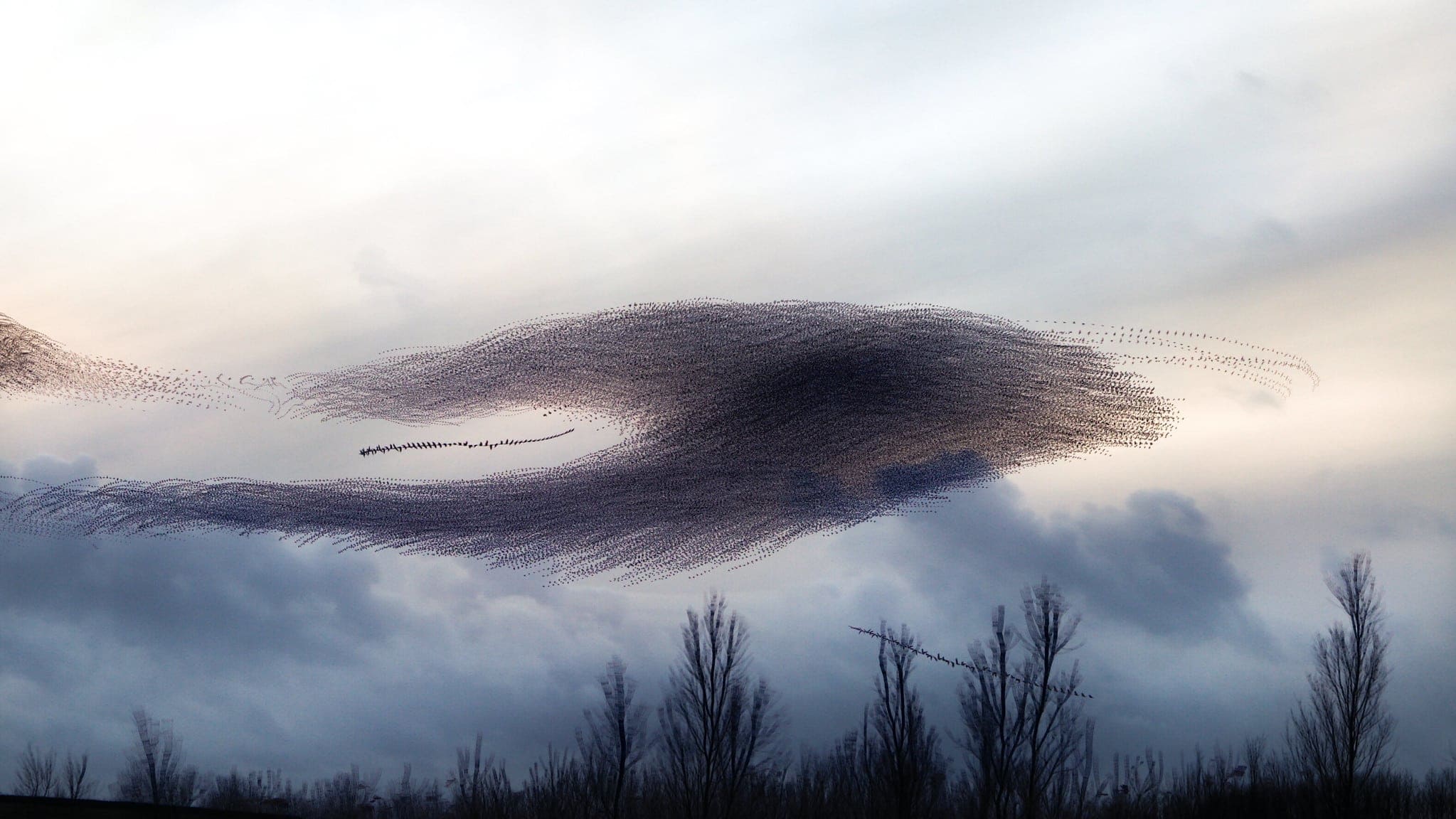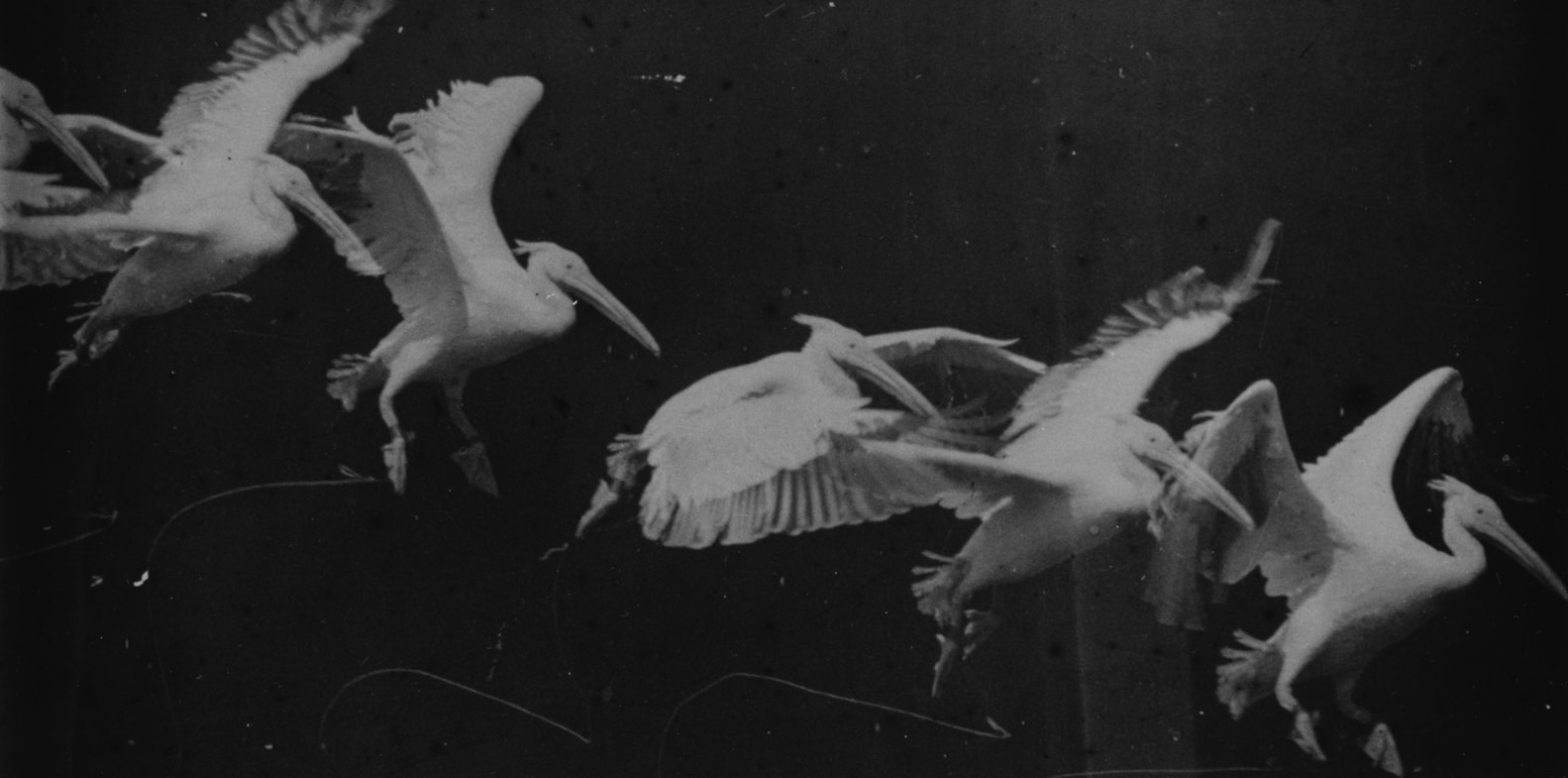
In the sleepy Derbyshire village of Stoney Middleton, Kathryn Cooper finds transient moments when chaos briefly changes to order – moments where thousands of individual bodies appear to move as one.

In 1989, Japan’s Shinkansen Bullet Train had a problem.
It was fast – incredibly fast – pushing 170 miles per hour. But every time it exited a tunnel it was unbearably loud. The air exited tunnels with a sonic boom that could be heard miles away, which in dense residential areas was a huge problem. So, an engineering team was brought in to design a quieter, faster, and more efficient train. And they had one secret weapon: Eiji Nakatsu – the general manager of the technical development department – was a birdwatcher.
Different components of the redesigned bullet train were based on different birds. Owls’ feathers inspired the pantograph (the rig that connects the train to the electric wires above) by using the same serrations and curvature that allow them to silently swoop down to catch prey. The Adelie Penguin – whose smooth body allows it to swim and slide effortlessly – inspired the pantograph’s shaft, redesigned for lower wind resistance. And the Kingfisher – a bird that dives into water to catch its prey while barely making a splash was used for its nose. The quietest nose design was the one modelled most closely after the Kingfisher’s beak. When the redesign debuted in 1997, it was remarkably quieter – and it did all that with the wings of an owl, the belly of a penguin, and the nose of a Kingfisher.
These are the mathematics of nature that have for so long fascinated Kathryn Cooper. The Sheffield-based photographer has travelled the world, but it is in her own county that she has found her calling.
ArrayArrayArrayA scientist by training, she positioned herself at the intersection between science and art, working alongside the physicists, mathematicians, and computer scientists who were working on such things as sequencing the genome. At Imperial College, she looked at finding ways to use mathematics to understand complex biological systems. This would later prove crucial to her photography.
As a rock climber, Cooper found herself going to South Africa time and time again. “And then I’d get back to the UK, looking at what we have here, and assuming like many others that we’re devoid of any real wildlife. We’re really not. There is so much on our doorstep.”
Being on the edge of the Peak District is a perfect venue for photography. The UK itself is a crucially important locale for wildlife sites, with a crux position off the Atlantic Gulf Stream. The starlings, little birds that have become Cooper’s raison d’être over the past few years, will spend most of the summer in places like Russia or Eastern Europe, and then will fly in gigantic flocks further south in winter.
Some starling gatherings have been reported to number over a million birds. They prefer sites where they return year after year, but their presence is not always guaranteed.
ArrayArrayArrayIn this particular season, Cooper focused on a starling roost on Middleton Moor, above the Derbyshire village of Stoney Middleton. “This was once a working village, home to many limestone quarries. With their closure, much of the site has been reclaimed by nature.” The mammoth pits dug for the stone were filled with rainwater, becoming pools of reedbeds often two metres high that the starlings would shelter in.
These give them safety from predators. Her most dramatic photographs show the starlings beginning their descent into the reedbeds. But whichever starling decides to first is at greatest risk of perishing.
“The crucial moment is when they decide to make the first move down to the safety of the beds…You’ll find as the winter progresses and the predators have got more and more hungry, usually sparrowhawks, peregrine falcons, or buzzards (who are hanging about for a casualty)”.
“The predators will almost take turns at the flock – they almost look like they have a strategy. And they’ll keep at it for as long as possible, as the starlings tire and begin to make mistakes while night breaks around them”.
ArrayArrayArray“There’s no leaders as such – but they demonstrate what is known as ‘collective intelligence’ – you can apply it us humans as well! – but each starling takes information from the ones around it in order to decide what to do. One will make a slight adjustment, the next one will make a slight adjustment – and it filters through these tens of thousands of birds to create these otherworldly shapes.”
The starlings for a while will not look like a shape. Just a furore of sound and movement. And then in a second, they transform into a unified, beautiful mass. A shape. “In mathematics you’d call that a critical point. A moment where you have the same system – all the same players – but you go from something completely random – to completely organised.”
…their movement as a flock – akin to human’s gait – is the tell-tale sign of their species
“It struck me that experienced birders can often identify a species in a single glance.” Even if the bird itself is a tiny speck, recognisable patterns in their movement as a flock – akin to human’s gait – is the tell-tale sign of their species.
“The swirling mass of birds can seem to appear out of nowhere, and just as quickly vanish. The fleeting shapes and patterns are a result of a precise mix of weather, season, food and predation and will never again be repeated.”
ArrayArrayArrayOne of Cooper’s returning statements is that to be a good wildlife photographer – you can be homegrown as much as a citizen of the world. Traipsing to Africa to capture one lion, once, in a particular time or light and depending on the animals behaviour, is not fundamentally understanding the art of wildlife photos.
The best advice Cooper has to give is that “if you want to take really good images, you’ve got to find somewhere that you can go to, time and time again. And that’s not going to be a holiday to the other side of the world. Someone else will have done it before.”
Traipsing to Africa to capture one lion, once, in a particular time or light and depending on the animals behaviour, is not understanding the art of wildlife photos
“But if you visit somewhere day in day out – you can see how it changes. You start to understand it and you see things that other people won’t see – which gives you a chance to experiment. it’s just a bit of a misnomer that there aren’t beautiful images to be found in your back garden.”
“Find somewhere that you love, and that you feel comfortable in. A lot of effort means a lot of time – and you will see things others have never.”

This year many have particularly realised how important nature is to us. “Nature’s evolution really is the ultimate way of finding a system that works, that’s all in balance.” Like Eiji Nukatsu’s work on the trains, it’s fascinating to know how interconnected maths is with the workings of nature. You apply the same mathematics for “describ[ing] a starling murmuration that you can to an avalanche” – natural processes where) something that’s completely stable goes to a critical point where everything’s in motion.
Cooper takes that further to what we’re seeing in our societies. “If you think of us as one of those little 3D points and we see how we’ve got so many interconnections.” It’s the same mathematics that describe “how ideas spread, how culture changes, how opinion changes” in society. The truest ‘human collective intelligence’, facilitated by the advent of rolling news and social media.

Marey’s Pelican
A separate part of Cooper’s work has been in refining her technique based on the Victorian ‘chronophotography’, where a sequence of images are taken to study motion. “I’ve got technology on my side, though! I’ll capture these birds through video – and then slow the frames down to take the exact movements.” Cooper refers to two fancy “Victorian gentlemen”, Eadweard Muybridge and Étienne-Jules Marey, who both found ways to combine frames into a single image, and take enough frames of movement to create a looping, moving image. One used a ‘photography gun’.
Their work, crucial to the advent of cinema, is revered by the northern photographer “they built their machines from scratch, it must have taken terrific vision to do this, I just have my video camera”. Indeed, Cooper films the starlings in motion, then slows down the frames to select the perfect ones. These equilibrium moments in starling murmurations are so short lived that photographing individual frames with a human index finger is nigh impossible.

Chronophotography Gun
To me, it looks like these starlings are points on a three-dimensional axis – each starling representing a singular piece of data. And I think that’s what draws Cooper to them. Because you imagine the photographer, coming from her past in whitewashed labs dealing with reams of data, to trekking to the top of limestone cliffs or the bottom of boggy reedbeds at the crack of dawn, or the break of night, watching her starlings dance above her in northern England, momentarily catching the balance she searches for.
But by doing this her way, and with her masses of birds, Kathryn Cooper can find these transient moments when chaos briefly changes to order – moments where thousands of individual bodies appear to move as one.
Cooper is exhibiting at exhibiting the Cley Contemporary Art exhibition throughout the month of July.





1 Comment
These photos are beautiful!